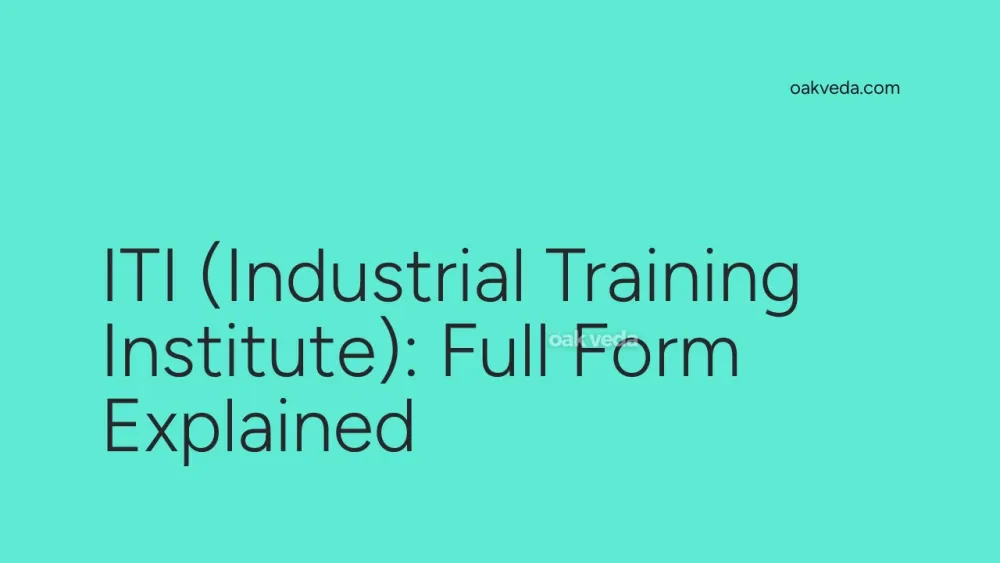
What is the Full Form of ITI?
The full form of ITI is Industrial Training Institute. These institutes play a crucial role in India's vocational education system, providing technical training to students who have completed their secondary education.
What is Industrial Training Institute?
Industrial Training Institute, commonly known as ITI, is a government-established training organization that offers industry-oriented education to high school graduates. These institutes aim to equip students with practical skills and technical knowledge, preparing them for various trades and industries.
Origin and Development of Industrial Training Institutes
The concept of ITIs in India dates back to the post-independence era when the country recognized the need for skilled workers to support its growing industrial sector. The Directorate General of Employment and Training (DGET), under the Ministry of Skill Development and Entrepreneurship, established these institutes to bridge the gap between formal education and industry requirements.
How do Industrial Training Institutes work?
ITIs function as vocational training centers that offer a wide range of courses in both engineering and non-engineering trades. The training programs are designed to be hands-on and practical, focusing on developing skills that are directly applicable in the industry. Upon completion of their courses, students appear for the All India Trade Test (AITT) and receive a National Trade Certificate (NTC) if they qualify.
Types of ITI Courses
ITI courses are broadly classified into two categories:
-
Engineering Trades: These courses focus on technical skills related to engineering, science, mathematics, and technology. Examples include:
- Electrician
- Fitter
- Carpenter
- Plumber
- Welder
-
Non-Engineering Trades: These courses concentrate on non-technical skills, including:
- Languages
- Soft skills
- Sector-specific competencies
Functions of Industrial Training Institutes
The primary functions of ITIs include:
- Providing vocational training to high school graduates
- Offering industry-relevant skills and knowledge
- Conducting apprenticeship programs
- Preparing students for immediate employment in various industries
- Administering the All India Trade Test (AITT)
- Issuing National Trade Certificates to qualified candidates
Applications of Industrial Training Institute Education
ITI education finds applications in various sectors:
- Manufacturing industries
- Construction and infrastructure development
- Automotive sector
- Electronics and electrical industries
- Service sector (hospitality, healthcare, etc.)
- Small and medium enterprises (SMEs)
Features of Industrial Training Institutes
Key features of ITIs include:
- Practical Training: Emphasis on hands-on learning and skill development
- Industry Partnerships: Collaborations with local industries for apprenticeships and placements
- Flexible Duration: Courses ranging from 6 months to 2 years
- Government Recognition: Certificates issued are recognized nationwide
- Affordable Education: Lower fees compared to traditional higher education
- Wide Accessibility: Presence of ITIs across urban and rural areas
Benefits of Industrial Training Institute Education
ITI education offers several advantages:
- Quick Skill Acquisition: Shorter duration courses for faster entry into the workforce
- Employment Readiness: Direct alignment with industry needs
- Entrepreneurship Opportunities: Skills that can lead to self-employment
- Career Advancement: Potential for higher positions with experience
- Diverse Career Options: Training in multiple trades allows for flexibility in career choices
- Continuous Learning: Option to pursue higher education while working
Limitations or Challenges of Industrial Training Institutes
Despite their benefits, ITIs face some challenges:
- Infrastructure Gaps: Some institutes lack modern equipment and facilities
- Curriculum Updates: Need for regular updates to keep pace with industry advancements
- Quality Variations: Differences in training quality between government and private ITIs
- Limited Soft Skills Focus: Some programs may not emphasize soft skills adequately
- Public Perception: Misconceptions about vocational education compared to traditional degrees
Future Developments in Industrial Training Institute Technology
The future of ITIs in India looks promising with several developments on the horizon:
- Digital Integration: Incorporation of online learning modules and virtual labs
- Industry 4.0 Readiness: Introduction of courses related to automation, AI, and IoT
- Green Skills: Focus on sustainable practices and renewable energy technologies
- Soft Skills Enhancement: Increased emphasis on communication and interpersonal skills
- International Collaborations: Partnerships with global institutions for knowledge exchange
- Entrepreneurship Focus: Programs to encourage and support student startups
FAQs on ITI Full Form
-
What is the eligibility criteria for ITI courses? Most ITI courses require candidates to have passed 10th grade from a recognized board, with a minimum aggregate of 35%. The age limit is typically between 14 and 40 years.
-
How many ITIs are there in India? As of recent data, there are over 15,000 ITIs in India, including both government (2,738) and private (12,304) institutes.
-
What is the admission process for ITIs? Government ITIs and reputable private institutes usually conduct merit-based admissions through written examinations. Some private ITIs may have direct admission processes.
-
Can ITI graduates pursue higher education? Yes, ITI graduates can pursue further studies, including diploma courses and even engineering degrees through lateral entry programs.
-
Are ITI courses recognized internationally? While ITI certificates are primarily recognized within India, some international companies and countries may accept them. However, additional certifications might be required for global recognition.
In conclusion, Industrial Training Institutes play a vital role in India's skill development landscape. By providing practical, industry-oriented training, ITIs contribute significantly to creating a skilled workforce ready to meet the demands of various sectors. As the country continues to focus on vocational education and skill development, the importance and reach of ITIs are likely to grow, offering more opportunities for students to build successful careers in their chosen trades.
You may be interested in:

